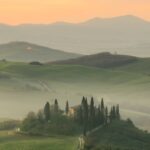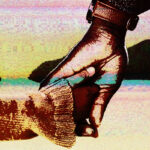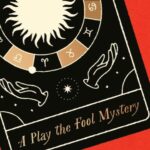On J.R.R. Tolkien and the Creation of the Modern
Fantasy Novel
This Week on the History of Literature Podcast
For tens of thousands of years, human beings have been using fictional devices to shape their worlds and communicate with one another. Four thousand years ago they began writing down these stories, and a great flourishing of human achievement began. We know it today as literature, a term broad enough to encompass everything from ancient epic poetry to contemporary novels. How did literature develop? What forms has it taken? And what can we learn from engaging with these works today? Hosted by Jacke Wilson, an amateur scholar with a lifelong passion for literature, The History of Literature takes a fresh look at some of the most compelling examples of creative genius the world has ever known.
John Ronald Reuel Tolkien (1892-1973) was a professor, academic essayist, and professional linguist—but the world knows him best as the author of The Hobbit (1937) and The Lord of the Rings (1954–1955). In this episode, Jacke finishes his look at literary genres by exploring the life, lifelong interests, and fantasy worlds of J.R.R. Tolkien, whose books sold over 150 million copies, inspired a highly successful movie trilogy, and essentially created the modern fantasy novel.
From the episode:
Jacke Wilson: One of the poems he found when he was studying Old English Studies was called “Crist” by Cynewulf. The poem had a somewhat cryptic couplet. This is the translation. It said, “Hail Earendel, brightest of angels / above the middle-earth sent unto men.” That word stopped him—Midgard is the word. It means Middle Earth. It stopped Tolkien in his tracks. Midgard was the everyday world between heaven above and hell below. Middle Earth. Middle Earth, of course. More grist for the fantasy mill.
Like I said, you can see all kinds of influences from his youth and young adulthood and life in these books. You can go see castles he lived near that turned into castles in the book, and the landscape of the shire is right there in the landscape of his childhood, and so on. The trip to Switzerland with the mountains. The words, too. The words that came his way and the myths that he was exposed to and that he sought out and studied and everything else.
Harry Potter works like this as well. You can go to Cambridge and Oxford and Edinburgh in London and see the kinds of train stations and alleys and roads and Hogwarts buildings right there. The world is invented, but there’s a grounding in reality, as if the fantasy author goes to see something that truly inspires them, or hears something, a myth or a word, that inspires them to think, what if? What if? What if this is a place where you might pull a sword out of a stone or encounter a creature: a fairy, an elf, a dwarf—a whole field of them, in fact? Or a race of creatures that only comes out of my mind that I’m putting together with what I know from other things. I can see that here. I can see a village. I can dream up such things as hobbits. Here’s what they look like, here’s how they talk. And here’s the giant quest for our hero to go on.
It’s a hero’s journey, naturally, one of Joseph Campbell’s monomyths. You can find all the stages of the monomyth in The Lord of the Rings and also in The Hobbit. You can see them all play out in the movies, too. The ring of power, the mysterious black riders, the evil trees that control the forest, and the hobbits who have to make their way through a perilous world. Tolkien wrote The Hobbit in 1937. His publishers loved it and wanted another story about hobbits, which Tolkien warned them, that’s going to take me a while. It’s going to take me a while to produce it. I’m going bigger now. I’ve got bigger plans, bigger things in mind. He started several times and had to set them aside. A few false starts.
Finally, the scope and the details of a new story came into view. He had a whole mythology to generate for this work, but luckily he had already done some of this and that work. The Silmarillion, which he drew upon. And he finally ended up with what we now know as the trilogy, which is divided into six books.
The book includes illustrations and more than 60 poems, which are about going to war and wandering, a life of wandering and drinking. There are riddles and prophecies and magical incantations. He made up a calligraphy for some of them and maps and an inscription for the ring and drawings for some of the places. He stuffed these books with his themes, the ones that interested him. And they come directly from all the concerns we’ve talked about already. He loved the Norse language and was in a club of people who studied the Vikings. That’s in there; you can see it. He learned Finnish; you can see that. The struggle of good and evil, straight from his deep and abiding Catholicism. His mother, whom he viewed as a martyr, handing him off to a priest for guidance and education before she died.
We have the struggle of good and evil; his love for history and myth and the etymology of words; his love for worlds like the world of Beowulf, where power struggles to do the right thing against unearthly creatures. The elements of hope and suffering and redemption, which run through those old English poems and give you a tantalizing glimpse of a society where men were pitted against monsters. His own fighting in the Great War. His life as an academic steeped in words and poetry and the sounds of language and breaking apart words into their component parts and unlocking their meanings and watching the history that rides along with those meanings. The way that words have not just meaning, but weight. The heaviness of history.
________________________
Subscribe now on iTunes, Spotify, Google Podcasts, Android, Stitcher, or wherever else you find your podcasts!
J.R.R. Tolkien is the creator of Middle-earth and author of such classic and extraordinary works of fiction as The Hobbit, The Lord of the Rings, and The Silmarillion. His books have been translated into more than fifty languages and have sold many millions of copies worldwide.




















